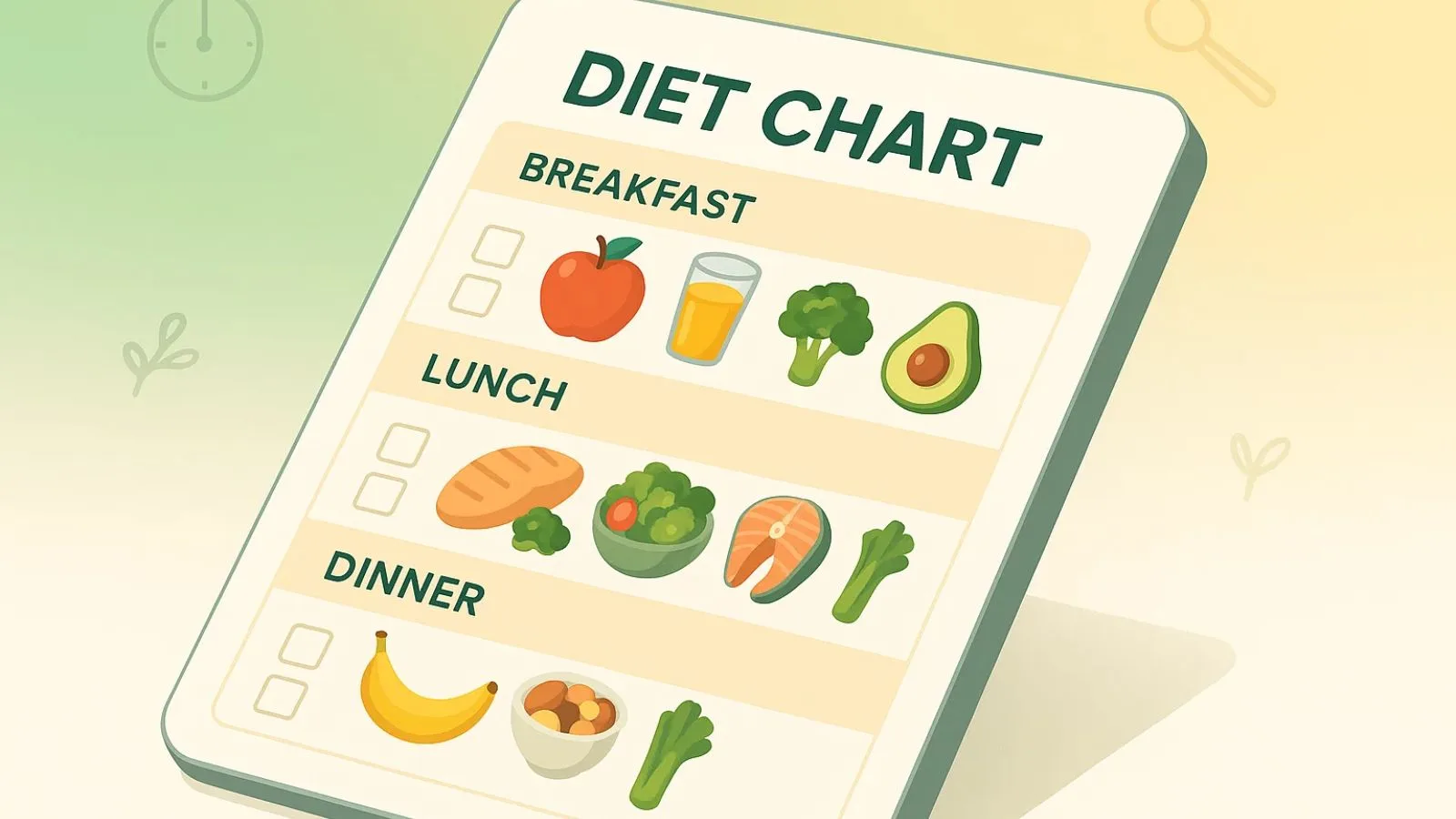Eating a balanced diet is one of the most important steps for long-term health. A proper diet doesn’t just fuel your body — it also supports mental clarity, immunity, and overall well-being. But with busy schedules and the constant temptation of processed foods, maintaining the right nutrient balance becomes difficult. This is where a diet chart becomes invaluable.
A diet chart helps you organise meals, control portions, and ensure you’re getting the right mix of proteins, carbohydrates, fats, vitamins, and minerals. Whether your goal is weight loss, weight gain diet plan, or simply feeling more energetic, a structured eating plan makes healthy eating easier and more consistent.
By following a well-designed, balanced diet chart, you can take control of your nutrition, avoid unhealthy food choices, and set yourself on a path toward a healthier lifestyle.
Listen To this Blog here,
What is a Diet Chart?
A diet chart is a structured plan that outlines what to eat, when to eat, and in what quantities. It serves as a guide to help individuals meet their nutritional needs while supporting specific health goals, such as weight loss, muscle gain, or general wellness.
A well-planned diet chart organizes meals throughout the day, including breakfast, lunch, dinner, and snacks, ensuring that all essential nutrients are included. By following a diet chart, you can maintain portion control, balance macronutrients like proteins, carbohydrates, and fats, and make healthier food choices consistently.
Different types of diet charts cater to various needs:
- Balanced diet chart for overall health
- Diet chart for weight loss to reduce calories while meeting nutrient requirements
- Healthy diet chart for women to address specific nutritional needs
- 7-day healthy eating plan to simplify meal planning and stay consistent
A diet chart acts as a roadmap to guide your daily food intake, making healthy eating easier, more consistent, and effective.
Key Components of a Balanced Diet Chart
A balanced diet chart ensures your body receives all the essential nutrients it needs to function optimally. Here are the key components to include:
- Proteins
Proteins are vital for building and repairing tissues, supporting muscle growth, and maintaining a healthy immune system. Sources include lean meats, fish, eggs, dairy, legumes, and nuts. - Carbohydrates
Carbohydrates provide energy for daily activities. Focus on complex carbs like whole grains, brown rice, oats, and vegetables, which release energy slowly and keep you full longer. - Fats
Healthy fats are essential for brain health, hormone production, and nutrient absorption. Include sources like olive oil, avocado, nuts, seeds, and fatty fish while avoiding trans fats. - Vitamins and Minerals
Micronutrients, including vitamins A, C, and D, as well as calcium and iron, are crucial for maintaining immunity, promoting bone health, and overall vitality. A variety of fruits, vegetables, dairy, and whole foods ensures adequate intake. - Fiber
Fiber aids digestion, regulates blood sugar, and promotes satiety. Incorporate fruits, vegetables, legumes, and whole grains into your meals. - Hydration
Water is essential for almost every bodily function. Aim for at least 8 glasses a day and adjust based on activity level and climate. - Portion Control
A balanced diet chart also emphasizes portion control to prevent overeating while ensuring nutrient needs are met.
Including these components in a healthy diet chart creates a strong foundation for sustained energy, improved health, and effective weight management.
Benefits of Following a Balanced Diet Chart
Following a balanced diet chart offers numerous benefits that impact both physical and mental well-being:
- Weight Management
A structured diet chart helps control calorie intake and ensures proper portion sizes, making it easier to achieve or maintain a healthy weight. - Increased Energy Levels
Balanced meals provide a steady supply of energy throughout the day, reducing fatigue and improving productivity. - Better Digestion and Gut Health
Including fiber-rich foods and staying hydrated supports healthy digestion and prevents constipation. - Stronger Immunity
Adequate vitamins, minerals, and antioxidants strengthen the immune system, helping the body fight infections more effectively. - Improved Mental Clarity
Proper nutrition supports brain function, enhancing focus, memory, and mood stability. - Long-Term Disease Prevention
A diet rich in nutrients can reduce the risk of chronic diseases like diabetes, heart disease, and osteoporosis.
By following a healthy diet chart, you not only improve your day-to-day energy and wellness but also lay the foundation for long-term health benefits.
Sample 7-Day Diet Plan for Weight Loss
Here’s an example of a 7-day diet plan for weight loss that balances nutrients while keeping meals simple and satisfying. Portions can be adjusted based on individual calorie needs.![]()
Day 1
- Breakfast: Oats with skim milk, chia seeds, and berries
- Snack: Apple slices with a handful of almonds
- Lunch: Grilled chicken with salad and olive oil dressing
- Snack: Carrot sticks with hummus
- Dinner: Steamed fish with quinoa and sautéed vegetables
2
- Breakfast: Greek yogurt with honey and walnuts
- Snack: Orange or a small bowl of papaya
- Lunch: Brown rice with lentil curry and steamed broccoli
- Snack: Handful of roasted chickpeas
- Dinner: Grilled tofu with stir-fried vegetables
3
- Breakfast: Whole-grain toast with avocado and boiled eggs
- Snack: Fresh fruit smoothie
- Lunch: Quinoa salad with cucumber, tomato, and chickpeas
- Snack: Mixed nuts
- Dinner: Baked chicken with roasted vegetables
4
- Breakfast: Oatmeal with banana slices and flax seeds
- Snack: Cucumber and carrot sticks
- Lunch: Grilled salmon with brown rice and green beans
- Snack: Low-fat yogurt
- Dinner: Stir-fried tofu with mixed vegetables
5
- Breakfast: Scrambled eggs with spinach and whole-grain toast
- Snack: Apple or pear
- Lunch: Chickpea salad with olive oil and lemon dressing
- Snack: Roasted nuts
- Dinner: Grilled fish with steamed broccoli and sweet potato
6
- Breakfast: Smoothie bowl with berries, oats, and seeds
- Snack: Fresh fruit
- Lunch: Lentil soup with whole-grain bread
- Snack: Carrot and celery sticks with hummus
- Dinner: Grilled chicken with quinoa and sautéed vegetables
Day 7
- Breakfast: Greek yogurt with granola and fresh fruit
- Snack: Handful of almonds
- Lunch: Brown rice with mixed vegetable curry
- Snack: Fruit smoothie
- Dinner: Baked tofu with roasted vegetables
This 7-day healthy eating plan ensures variety, balances nutrients, and promotes weight loss in a sustainable way.
Stay on Track with Calorie Tracker Buddy
Following a diet chart can sometimes feel challenging, especially when it comes to tracking calories, nutrients, and portion sizes. This is where Calorie Tracker Buddy can make a real difference. It’s a user-friendly tool designed to help you log your meals, monitor daily calorie intake, and ensure your nutrient requirements are met.
With Calorie Tracker Buddy, you can:
- Track Calories Easily: Log your breakfast, lunch, dinner, and snacks in seconds to see how many calories you’re consuming.
- Monitor Nutrients: Keep an eye on proteins, carbs, fats, and essential vitamins and minerals.
- Plan Meals Effectively: Align your daily intake with your goals, whether it’s weight loss, muscle gain, or maintaining a healthy lifestyle.
- Stay Consistent: The tool helps you stick to your balanced diet chart by providing insights and reminders for healthier eating.
By combining a structured diet chart with a tracking tool like Calorie Tracker Buddy, you gain better control over your nutrition, make smarter food choices, and reach your health goals more efficiently. It’s like having a personal nutrition assistant right in your pocket, helping you stay accountable and motivated every day.
Healthy Diet Chart for Women
Women have unique nutritional needs due to factors like hormonal changes, menstrual cycles, and bone health. A healthy diet chart for women should focus on:
- Iron-Rich Foods
Leafy greens, legumes, and lean meats help prevent anemia and support energy levels. - Calcium and Vitamin D
Dairy products, fortified plant-based milk, and sunlight exposure support bone health and reduce the risk of osteoporosis. - Protein
Adequate protein from eggs, fish, beans, and nuts aids muscle maintenance and metabolism. - Healthy Fats
Include omega-3-rich foods like fish, flaxseeds, and walnuts for heart and brain health. - Fiber and Hydration
Fruits, vegetables, and whole grains improve digestion and maintain satiety throughout the day.
A healthy diet chart for women ensures balanced nutrition while addressing specific health needs. Small adjustments, like incorporating iron-rich snacks or calcium sources, can make a significant difference in overall wellness.
Tips for Creating Your Own Balanced Diet Chart
Creating a balanced diet chart tailored to your lifestyle can make healthy eating sustainable and enjoyable. Here are some practical tips:
- Choose Nutrient-Dense Foods
Focus on whole grains, lean proteins, fruits, vegetables, and healthy fats to get the most nutrition from every meal. - Plan Meals Ahead
Prepare a weekly plan to avoid last-minute unhealthy choices and ensure variety. - Practice Portion Control
Use standard serving sizes to prevent overeating while still meeting nutrient needs. - Incorporate Variety
Rotate different fruits, vegetables, proteins, and grains to cover all essential nutrients and prevent meal monotony. - Set Meal Timings
Consistent meal timing helps regulate metabolism and maintain energy levels throughout the day. - Include Healthy Snacks
Fruits, nuts, or yogurt between meals prevent energy dips and reduce cravings. - Stay Flexible
Your diet chart should guide you, not restrict you. Adjust based on activity level, preferences, or special occasions.
By following these tips, you can design a healthy diet chart that fits your lifestyle and supports long-term health goals.
Common Mistakes to Avoid
When following a diet chart, it’s important to avoid common pitfalls that can hinder progress:
- Skipping Meals
Skipping meals can slow metabolism and lead to overeating later in the day. - Over-Restricting Calories
Extreme calorie restriction may cause nutrient deficiencies and affect energy levels. - Ignoring Hydration
Water is essential for digestion, metabolism, and overall health. Dehydration can reduce energy and focus. - Relying Too Much on Supplements
Supplements cannot replace whole foods. A diet rich in natural nutrients is always preferable. - Eating the Same Foods Repeatedly
A lack of variety can lead to nutrient gaps and make it harder to stick to the plan.
Avoiding these mistakes helps you get the most benefits from your diet chart and maintain a sustainable, healthy lifestyle.![]()
Conclusion
A well-planned diet chart is a powerful tool for achieving a healthier lifestyle, managing weight, and meeting your nutritional needs. By focusing on balanced meals, proper portion sizes, and nutrient diversity, you can enjoy better energy, improved digestion, and long-term wellness.
Whether you follow a 7-day diet plan for weight loss, a healthy diet chart for women, or create a personalized balanced diet chart, consistency and variety are key. Small, mindful changes to your eating habits can have a lasting impact on your overall health.
Following a diet chart makes it easier to stay on track, make informed food choices, and maintain a sustainable routine for optimal well-being.
FAQs:
- How often should I update my diet chart?
It’s a good idea to review and update your diet chart every few weeks or whenever your health goals change. Adjusting portion sizes, meal timing, or food choices ensures the chart continues to meet your nutritional needs and lifestyle. - Can I follow a diet chart if I have a busy schedule?
Absolutely. A diet chart can be customized to fit your daily routine. Pre-planning meals, prepping snacks in advance, and choosing quick, healthy options make it possible to maintain balanced eating even on busy days. - Is it okay to cheat occasionally while following a diet chart?
Yes, occasional treats can be included without derailing progress. The key is moderation and balance. Planning indulgences into your diet chart helps prevent cravings and makes healthy eating sustainable in the long term.